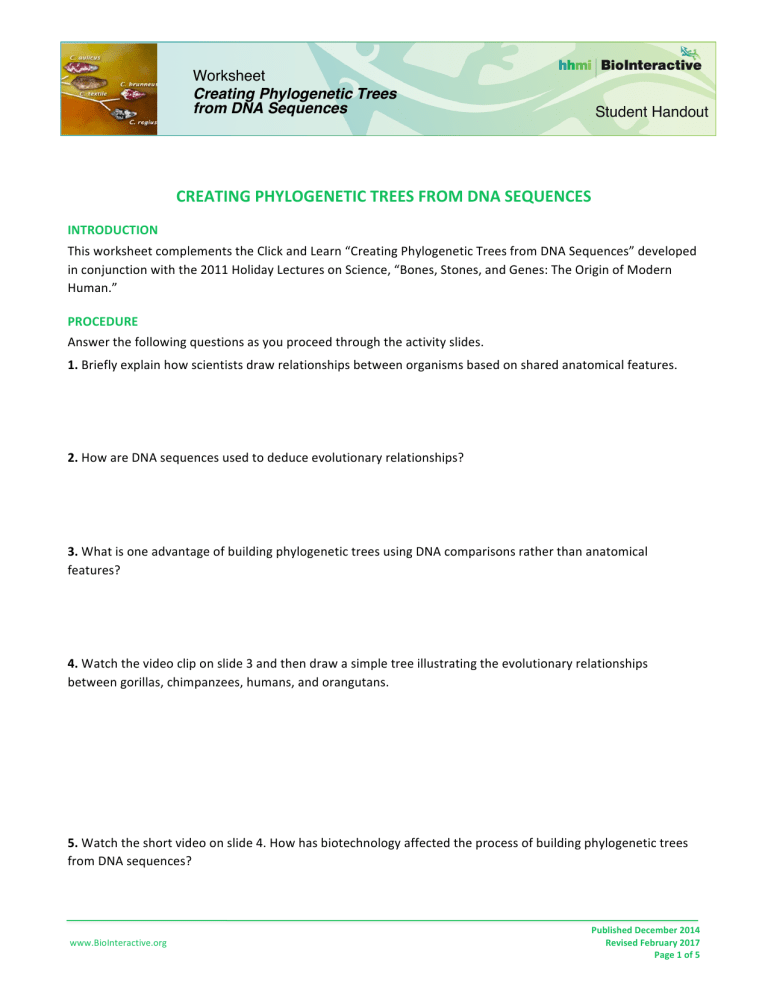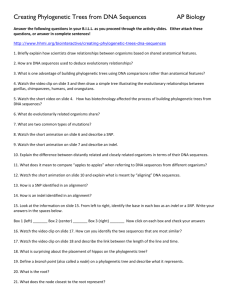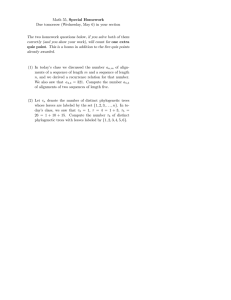Phylogenetic Trees from DNA Sequences Worksheet
advertisement

Worksheet Creating Phylogenetic Trees from DNA Sequences Student Handout CREATING PHYLOGENETIC TREES FROM DNA SEQUENCES INTRODUCTION This worksheet complements the Click and Learn “Creating Phylogenetic Trees from DNA Sequences” developed in conjunction with the 2011 Holiday Lectures on Science, “Bones, Stones, and Genes: The Origin of Modern Human.” PROCEDURE Answer the following questions as you proceed through the activity slides. 1. Briefly explain how scientists draw relationships between organisms based on shared anatomical features. 2. How are DNA sequences used to deduce evolutionary relationships? 3. What is one advantage of building phylogenetic trees using DNA comparisons rather than anatomical features? 4. Watch the video clip on slide 3 and then draw a simple tree illustrating the evolutionary relationships between gorillas, chimpanzees, humans, and orangutans. 5. Watch the short video on slide 4. How has biotechnology affected the process of building phylogenetic trees from DNA sequences? www.BioInteractive.org Published December 2014 Revised February 2017 Page 1 of 5 Worksheet Creating Phylogenetic Trees from DNA Sequences Student Handout 6. What do evolutionarily related organisms share? 7. What are two common types of mutations? 8. Watch the short animation on slide 6 and describe a SNP. 9. Watch the short animation on slide 7 and describe an indel. 10. Explain the difference between distantly related and closely related organisms in terms of their DNA sequences. 11. What does it mean to compare “apples to apples” when referring to DNA sequences from different organisms? 12. Watch the short animation on slide 10 and explain what is meant by “aligning” DNA sequences. 13. How is a SNP identified in an alignment? 14. How is an indel identified in an alignment? www.BioInteractive.org Published December 2014 Revised February 2017 Page 2 of 5 Worksheet Creating Phylogenetic Trees from DNA Sequences Student Handout 15. Look at the information on slide 15. From left to right, identify the base in each box as an indel or a SNP. Write your answers in the spaces below. Box 1 (left) Box 2 (center) Box3 (right) Now click on each box and check your answers to Question 15 above. 16. Watch the video clip on slide 17. How can you identify the two sequences that are most similar? 17. Watch the video clip on slide 18 and describe the link between the length of the line and time. 18. What is surprising about the placement of hippos on the phylogenetic tree? 19. Define a branch point (also called a node) on a phylogenetic tree and describe what it represents. 20. What is the root? 21. What does the node closest to the root represent? 22. Describe what an unrooted phylogenetic tree represents. 23. On slides 22 and 23, notice how phylogenetic trees can rotate around nodes and have different shapes. Notice the relationships between the organisms do not change. 24. Using the information on slide 24, explain how DNA evidence supports the known biology of the seven cone snails. www.BioInteractive.org Published December 2014 Revised February 2017 Page 3 of 5 Worksheet Creating Phylogenetic Trees from DNA Sequences Student Handout 25. Write three conclusions drawn from the information provided in this Click and Learn. a. b. c. www.BioInteractive.org Published December 2014 Revised February 2017 Page 4 of 5 Worksheet Creating Phylogenetic Trees from DNA Sequences Student Worksheet EXTENSION ACTIVITY Address the following concepts in essay form in the space provided below. Phylogeny is the evolutionary history of a species: a. The evolution of a species is dependent on changes in the genome of the species. Identify two mechanisms of genetic change, and explain how each affects genetic variation. b. Describe two types of evidence–other than the comparison of DNA sequences–that can be used to determine the phylogeny of organisms. Discuss one strength of each type of evidence you described. www.BioInteractive.org Published December 2014 Revised February 2017 Page 5 of 5


